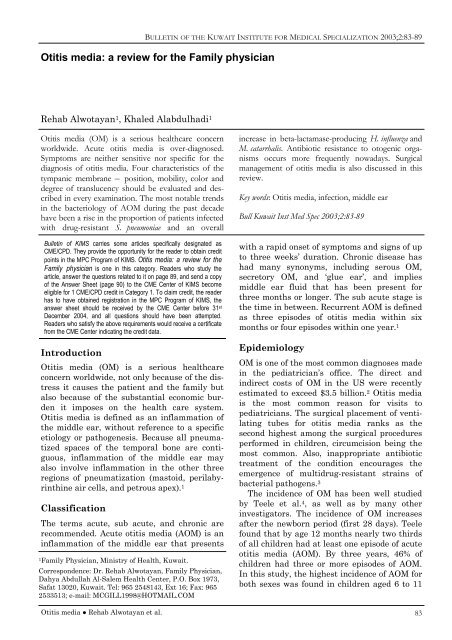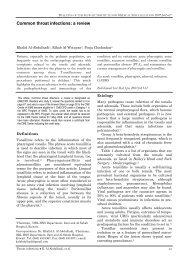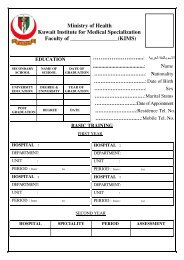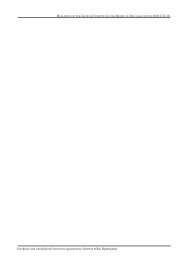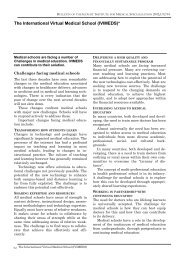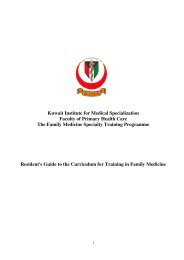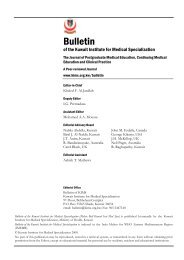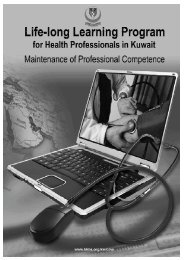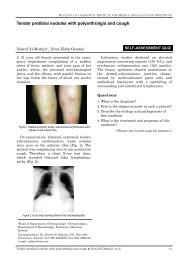Otitis media: a review for the Family physician - Kuwait Institute for ...
Otitis media: a review for the Family physician - Kuwait Institute for ...
Otitis media: a review for the Family physician - Kuwait Institute for ...
Create successful ePaper yourself
Turn your PDF publications into a flip-book with our unique Google optimized e-Paper software.
<strong>Otitis</strong> <strong>media</strong> ● Rehab Alwotayan et al.<br />
BULLETIN OF THE KUWAIT INSTITUTE FOR MEDICAL SPECIALIZATION 2003;2:83-89<br />
<strong>Otitis</strong> <strong>media</strong>: a <strong>review</strong> <strong>for</strong> <strong>the</strong> <strong>Family</strong> <strong>physician</strong><br />
Rehab Alwotayan 1 , Khaled Alabdulhadi 1<br />
<strong>Otitis</strong> <strong>media</strong> (OM) is a serious healthcare concern<br />
worldwide. Acute otitis <strong>media</strong> is over-diagnosed.<br />
Symptoms are nei<strong>the</strong>r sensitive nor specific <strong>for</strong> <strong>the</strong><br />
diagnosis of otitis <strong>media</strong>. Four characteristics of <strong>the</strong><br />
tympanic membrane – position, mobility, color and<br />
degree of translucency should be evaluated and described<br />
in every examination. The most notable trends<br />
in <strong>the</strong> bacteriology of AOM during <strong>the</strong> past decade<br />
have been a rise in <strong>the</strong> proportion of patients infected<br />
with drug-resistant S. pneumoniae and an overall<br />
Bulletin of KIMS carries some articles specifically designated as<br />
CME/CPD. They provide <strong>the</strong> opportunity <strong>for</strong> <strong>the</strong> reader to obtain credit<br />
points in <strong>the</strong> MPC Program of KIMS. <strong>Otitis</strong> <strong>media</strong>: a <strong>review</strong> <strong>for</strong> <strong>the</strong><br />
<strong>Family</strong> <strong>physician</strong> is one in this category. Readers who study <strong>the</strong><br />
article, answer <strong>the</strong> questions related to it on page 89, and send a copy<br />
of <strong>the</strong> Answer Sheet (page 90) to <strong>the</strong> CME Center of KIMS become<br />
eligible <strong>for</strong> 1 CME/CPD credit in Category 1. To claim credit, <strong>the</strong> reader<br />
has to have obtained registration in <strong>the</strong> MPC Program of KIMS, <strong>the</strong><br />
answer sheet should be received by <strong>the</strong> CME Center be<strong>for</strong>e 31 st<br />
December 2004, and all questions should have been attempted.<br />
Readers who satisfy <strong>the</strong> above requirements would receive a certificate<br />
from <strong>the</strong> CME Center indicating <strong>the</strong> credit data.<br />
Introduction<br />
<strong>Otitis</strong> <strong>media</strong> (OM) is a serious healthcare<br />
concern worldwide, not only because of <strong>the</strong> distress<br />
it causes <strong>the</strong> patient and <strong>the</strong> family but<br />
also because of <strong>the</strong> substantial economic burden<br />
it imposes on <strong>the</strong> health care system.<br />
<strong>Otitis</strong> <strong>media</strong> is defined as an inflammation of<br />
<strong>the</strong> middle ear, without reference to a specific<br />
etiology or pathogenesis. Because all pneumatized<br />
spaces of <strong>the</strong> temporal bone are contiguous,<br />
inflammation of <strong>the</strong> middle ear may<br />
also involve inflammation in <strong>the</strong> o<strong>the</strong>r three<br />
regions of pneumatization (mastoid, perilabyrinthine<br />
air cells, and petrous apex). 1<br />
Classification<br />
The terms acute, sub acute, and chronic are<br />
recommended. Acute otitis <strong>media</strong> (AOM) is an<br />
inflammation of <strong>the</strong> middle ear that presents<br />
1<strong>Family</strong> Physician, Ministry of Health, <strong>Kuwait</strong>.<br />
Correspondence: Dr. Rehab Alwotayan, <strong>Family</strong> Physician,<br />
Dahya Abdullah Al-Salem Health Center, P.O. Box 1973,<br />
Safat 13020, <strong>Kuwait</strong>. Tel: 965 2548143, Ext 16; Fax: 965<br />
2533513; e-mail: MCGILL1998@HOTMAIL.COM<br />
increase in beta-lactamase-producing H. influenza and<br />
M. catarrhalis. Antibiotic resistance to otogenic organisms<br />
occurs more frequently nowadays. Surgical<br />
management of otitis <strong>media</strong> is also discussed in this<br />
<strong>review</strong>.<br />
Key words: <strong>Otitis</strong> <strong>media</strong>, infection, middle ear<br />
Bull <strong>Kuwait</strong> Inst Med Spec 2003;2:83-89<br />
with a rapid onset of symptoms and signs of up<br />
to three weeks’ duration. Chronic disease has<br />
had many synonyms, including serous OM,<br />
secretory OM, and ‘glue ear’, and implies<br />
middle ear fluid that has been present <strong>for</strong><br />
three months or longer. The sub acute stage is<br />
<strong>the</strong> time in between. Recurrent AOM is defined<br />
as three episodes of otitis <strong>media</strong> within six<br />
months or four episodes within one year. 1<br />
Epidemiology<br />
OM is one of <strong>the</strong> most common diagnoses made<br />
in <strong>the</strong> pediatrician’s office. The direct and<br />
indirect costs of OM in <strong>the</strong> US were recently<br />
estimated to exceed $3.5 billion. 2 <strong>Otitis</strong> <strong>media</strong><br />
is <strong>the</strong> most common reason <strong>for</strong> visits to<br />
pediatricians. The surgical placement of ventilating<br />
tubes <strong>for</strong> otitis <strong>media</strong> ranks as <strong>the</strong><br />
second highest among <strong>the</strong> surgical procedures<br />
per<strong>for</strong>med in children, circumcision being <strong>the</strong><br />
most common. Also, inappropriate antibiotic<br />
treatment of <strong>the</strong> condition encourages <strong>the</strong><br />
emergence of multidrug-resistant strains of<br />
bacterial pathogens. 3<br />
The incidence of OM has been well studied<br />
by Teele et al. 4, as well as by many o<strong>the</strong>r<br />
investigators. The incidence of OM increases<br />
after <strong>the</strong> newborn period (first 28 days). Teele<br />
found that by age 12 months nearly two thirds<br />
of all children had at least one episode of acute<br />
otitis <strong>media</strong> (AOM). By three years, 46% of<br />
children had three or more episodes of AOM.<br />
In this study, <strong>the</strong> highest incidence of AOM <strong>for</strong><br />
both sexes was found in children aged 6 to 11<br />
83
BULLETIN OF THE KUWAIT INSTITUTE FOR MEDICAL SPECIALIZATION 2003;2:83-89<br />
months. Some investigators have also noted a<br />
second, lower peak between ages 4 and 5 years.<br />
The onset of AOM during <strong>the</strong> first year of life<br />
is important because <strong>the</strong> majority of children<br />
with multiple recurrences of AOM have <strong>the</strong>ir<br />
first episode be<strong>for</strong>e <strong>the</strong> age of 12 months. 1<br />
An epidemiological survey in Saudi Arabia<br />
was carried out with 9540 children aged up to<br />
12 years to study <strong>the</strong> prevalence of acute otitis<br />
<strong>media</strong> and <strong>the</strong> rate of hearing impairment. A<br />
total of 100 (1.05%) were diagnosed with acute<br />
otitis <strong>media</strong>. The incidence was found to be<br />
higher among young children up to 4 years old<br />
and lower in <strong>the</strong> age group 8-12 years. Also it<br />
was found that <strong>the</strong> prevalence of AOM was<br />
higher among children whose parents were<br />
cousins compared with children of non-related<br />
parents. There is also evidence to indicate that<br />
poor socio-economic backgrounds and inadequate<br />
health services are associated with a<br />
higher rate of <strong>the</strong> condition. 5<br />
After an episode of AOM, <strong>the</strong>re is a high<br />
incidence of persistent middle ear effusion<br />
(MEE) occurring. One study found that <strong>the</strong><br />
mean duration of otitis <strong>media</strong> with effusion<br />
(OME) after AOM was 40 days. Shurin et al.<br />
reported that children who were younger than<br />
24 months of age were 3.8 times more likely to<br />
have persistent MEE than those who were<br />
older. 6 They also found a higher incidence of<br />
persistent effusion in white children.<br />
Varying distribution among sexes has not<br />
been found. Some studies have shown an<br />
increased preponderance in males when compared<br />
to females but o<strong>the</strong>rs have challenged<br />
this finding, citing an equal distribution. 1<br />
Children in group daycare have been shown<br />
to be more likely to have OM as a complication<br />
of an upper respiratory tract infection when<br />
compared to those in home care. Niemala et al.<br />
found that <strong>the</strong> rate of tympanostomies and<br />
adenoidectomies was 59-67% higher <strong>for</strong> children<br />
below <strong>the</strong> age of three who were cared <strong>for</strong><br />
at a daycare center. 7 Contributing factors <strong>for</strong><br />
this increased incidence may include large<br />
numbers of children in close proximity and<br />
increased incidence of upper respiratory infections,<br />
with resultant frequent examinations by<br />
<strong>physician</strong>s.<br />
The incidence of OM parallels <strong>the</strong> incidence<br />
of upper respiratory tract infections, which are<br />
most prevalent during <strong>the</strong> winter months. OM<br />
is also common in <strong>the</strong> spring and fall, and least<br />
common during <strong>the</strong> summer. It has been found<br />
84<br />
that MEE originating in <strong>the</strong> winter months<br />
appears to last longer than those occurring in<br />
<strong>the</strong> summer months. 1<br />
There is data strongly suggesting a genetic<br />
susceptibility to OM. Variables associated with<br />
an increased risk of AOM include a sibling history<br />
of recurrent OM. 8<br />
Breast-feeding has been suggested as an<br />
important factor in <strong>the</strong> prevention of respiratory<br />
tract infections and middle ear disease in<br />
infancy. Many studies have shown an inverse<br />
relationship between <strong>the</strong> incidence of middle<br />
ear disease and <strong>the</strong> duration of breast-feeding.<br />
The mechanism of <strong>the</strong> protective effect of<br />
breast milk remains obscure. Data from a<br />
study of infants with cleft palate 8 suggest that<br />
it is a factor in breast milk, and not <strong>the</strong><br />
position or mode of feeding, as some have<br />
suggested, that is protective. Two o<strong>the</strong>r studies<br />
indicate that breast-feeding had no effect on<br />
colonization of <strong>the</strong> nasopharynx with bacterial<br />
pathogens, indicating that <strong>the</strong> mechanism of<br />
protection relies on some immune-protective<br />
feature unassociated with prevention of colonization.<br />
9,10<br />
Passive smoke exposure has come under<br />
increased scrutiny as a risk factor <strong>for</strong> respiratory<br />
tract infections, including OM, because of<br />
pathological and physiological changes in <strong>the</strong><br />
respiratory tract: goblet cell hyperplasia,<br />
mucus hypersecretion, ciliostasis, decreased<br />
mucociliary transport, and alteration of <strong>the</strong><br />
immune defenses. There is also an increased<br />
incidence of placement of tympanostomy tubes,<br />
chronic and recurrent OM, and otorrhea in<br />
children whose mo<strong>the</strong>rs smoked. 9<br />
Many associated medical conditions predispose<br />
a child to OM. Cleft palate and craniofacial<br />
anomalies, especially if <strong>the</strong> midface is<br />
involved, appear to be related to an increased<br />
risk of OM. The incidence of middle ear disease<br />
decreases somewhat after surgical repair of<br />
cleft palate but <strong>the</strong>se children may continue to<br />
have frequent middle ear problems <strong>for</strong> years.<br />
There is an increased incidence of OM in children<br />
with congenital or acquired immune<br />
dysfunction (IgG subclass deficiency, AIDS,<br />
medications). Ciliary dysfunction frequently<br />
predisposes a child to OM (OM may be <strong>the</strong> first<br />
presenting sign of Kartagener’s syndrome). 1<br />
Edema of <strong>the</strong> nasopharynx and Eustachian<br />
tube (E.T.) from prolonged nasotracheal intubation<br />
or nasogastric tube placement may lead<br />
to OM and sinusitis. Nasal obstruction from<br />
<strong>Otitis</strong> <strong>media</strong> ● Rehab Alwotayan et al.
enlarged adenoids, sinusitis, and malignancy<br />
can also lead to OM. 1<br />
Physiology<br />
The Eustachian tube has at least three physiologic<br />
functions with respect to <strong>the</strong> middle ear:<br />
1) protection from nasopharyngeal sound pressure<br />
and secretions, 2) clearance into <strong>the</strong> nasopharynx<br />
of secretions produced within <strong>the</strong><br />
middle ear, and 3) ventilation of <strong>the</strong> middle ear<br />
to equilibrate air pressure in <strong>the</strong> middle ear<br />
with atmospheric pressure and to replenish<br />
oxygen that has been absorbed. 1<br />
In <strong>the</strong> healthy state <strong>the</strong> middle ear and mastoid<br />
are protected from unwanted nasopharyngeal<br />
secretions by <strong>the</strong> anatomy of <strong>the</strong> Eustachian<br />
tube system and by <strong>the</strong> middle ear gas<br />
cushion. The Eustachian tube connects <strong>the</strong><br />
middle ear and mastoid air cells to <strong>the</strong> nasopharynx.<br />
In <strong>the</strong> adult, <strong>the</strong> anterior two thirds<br />
of <strong>the</strong> tube are cartilaginous and <strong>the</strong> posterior<br />
third is bony; in <strong>the</strong> infant, <strong>the</strong> bony portion is<br />
relatively longer. In adults, <strong>the</strong> tube lies at an<br />
angle of 45° in relation to <strong>the</strong> horizontal plane,<br />
whereas in infants this inclination is only 10°.<br />
The nasopharyngeal orifice of <strong>the</strong> E.T. in <strong>the</strong><br />
adult is a vertical slit at right angels to <strong>the</strong><br />
base of <strong>the</strong> skull, but in <strong>the</strong> infant this opening<br />
is oblique owing to <strong>the</strong> more horizontal position<br />
of <strong>the</strong> cartilage. These factors predispose<br />
children to increased incidence of otits<br />
<strong>media</strong>. 1,8<br />
Diagnosis of <strong>Otitis</strong> Media<br />
Every family <strong>physician</strong> is well aware of <strong>the</strong><br />
diagnostic dilemma posed by an ill child who<br />
may or may not have acute otitis <strong>media</strong>. In<br />
even <strong>the</strong> most experienced hands, an adequate<br />
physical examination of <strong>the</strong> ears can be difficult<br />
to per<strong>for</strong>m because of common problems<br />
such as cerumen blockage of <strong>the</strong> auditory<br />
canal, an uncooperative toddler, or because of<br />
inadequate visualization of <strong>the</strong> tympanic membrane<br />
due to low light output from old otoscope<br />
bulbs. 11<br />
Acute otitis <strong>media</strong> is over-diagnosed. Symptoms<br />
are nei<strong>the</strong>r sensitive nor specific <strong>for</strong> <strong>the</strong><br />
diagnosis of otitis <strong>media</strong>; fever and ear pain<br />
are present in only one half of patients. 10 Many<br />
<strong>physician</strong>s rely on redness of <strong>the</strong> eardrum as<br />
<strong>the</strong> main diagnostic clue. Crying (and most<br />
young children cry when <strong>the</strong>ir ears are examined),<br />
removal of cerumen with associated<br />
<strong>Otitis</strong> <strong>media</strong> ● Rehab Alwotayan et al.<br />
BULLETIN OF THE KUWAIT INSTITUTE FOR MEDICAL SPECIALIZATION 2003;2:83-89<br />
irritation of <strong>the</strong> auditory canal and fever can<br />
all cause redness of <strong>the</strong> eardrum in <strong>the</strong><br />
absence of middle ear infection. Most of all,<br />
when a parent brings a child to <strong>the</strong> <strong>physician</strong><br />
because of irritability, rhinorrhea and fever,<br />
<strong>the</strong> temptation is great to see at least a little<br />
bit of redness or fluid behind <strong>the</strong> eardrum as<br />
justification <strong>for</strong> an antibiotic prescription. 11<br />
Four characteristics of <strong>the</strong> tympanic membrane<br />
− position, mobility, color and degree of<br />
translucency − should be evaluated and described<br />
in every examination. The normal tympanic<br />
membrane is in <strong>the</strong> neutral position<br />
(nei<strong>the</strong>r retracted nor bulging), pearly gray,<br />
translucent and responding briskly to positive<br />
and negative pressure, indicating air filled<br />
space. An abnormal tympanic membrane may<br />
be retracted or bulging, and immobile or poorly<br />
mobile to positive or negative air pressure. The<br />
color of eardrum is less important than <strong>the</strong><br />
position and mobility. There<strong>for</strong>e, <strong>the</strong> redness of<br />
<strong>the</strong> tympanic membrane alone does not<br />
suggest <strong>the</strong> diagnosis of acute otitis <strong>media</strong>. 11<br />
Tympanometry provides additional in<strong>for</strong>mation<br />
about actual pressure within <strong>the</strong> middle<br />
ear space. It measures <strong>the</strong> amount of sound<br />
reflected by <strong>the</strong> tympanic membrane and<br />
middle ear structures under varying conditions,<br />
and is a graphic representation of compliance<br />
changes. Various patterns are associated<br />
with normal, middle ear fluid, per<strong>for</strong>ations<br />
or tympanostomies, retracted TMs, and stiff<br />
TM/middle ear systems. These data should, of<br />
course, be correlated with physical examination.<br />
1,12<br />
Microbiology<br />
With <strong>the</strong> exception of Moraxella catarrhalis,<br />
<strong>the</strong> list of bacteria causing OM has not appreciably<br />
changed <strong>for</strong> many years, and appears to<br />
be similar worldwide. Approximately 30 to 35%<br />
of cases are caused by Streptococcus pneumoniae,<br />
20 to 25% by nontypeable strains of<br />
Hemophilus influenzae and 10 to 15% by M.<br />
catarrhalis. The frequency of M. catarrhalis in<br />
otitis appears to have increased in <strong>the</strong> last<br />
decade. The group A streptococcus causes<br />
acute middle ear infection in 2 to 4% of children,<br />
and tends to occur in early spring.<br />
Staphylococcus aureus, gram-negative enteric<br />
bacilli, and o<strong>the</strong>r bacteria are found consistently<br />
but less frequently. In infants younger<br />
than 6 weeks of age, gram-negative bacilli<br />
85
BULLETIN OF THE KUWAIT INSTITUTE FOR MEDICAL SPECIALIZATION 2003;2:83-89<br />
cause about 20% of <strong>the</strong> AOM episodes. These<br />
organisms include Escherichia coli, Klebsiella,<br />
and Pseudomonas aeruginosa. Even in <strong>the</strong>se<br />
very young infants, however, <strong>the</strong> most common<br />
organisms are still S. pneumoniae and H.<br />
influenzae. 13 Most studies show that 25 to 30%<br />
of middle ear fluid cultures are negative <strong>for</strong><br />
bacteria. Some of <strong>the</strong> cultures are positive <strong>for</strong><br />
viruses, including rhinovirus, adenovirus,<br />
influenza virus, parainfluenza virus, and respiratory<br />
syncytial virus (RSV). Recently viruses<br />
have gained increasing attention as possible<br />
co-pathogenic organisms in both acute and<br />
chronic OME, and may contribute to <strong>the</strong> prolongation<br />
of middle ear effusion. For many<br />
years, <strong>physician</strong>s presumed that viral illness<br />
produced mucosal inflammation and edema<br />
resulting in Eustachian tube dysfunction<br />
characterized by partial or complete obstructtion<br />
of <strong>the</strong> passage and by accumulation of<br />
fluid in some patients. This was recently<br />
confirmed in a study of young adults with<br />
natural rhinovirus infection. 14 Middle ear pressure<br />
changes were measured by a digital tympanometer<br />
at intervals during <strong>the</strong> illness of<br />
<strong>the</strong>se subjects. Abnormal pressure occurred in<br />
74% of patients with rhinovirus illness, and<br />
more than half of <strong>the</strong>se subjects had major<br />
pressure abnormalities. The frequency of subjects<br />
with abnormal middle ear pressures<br />
peaked on days 2 to 5 of illness, a time that<br />
coincides with <strong>the</strong> peak incidence of acute<br />
otitis <strong>media</strong> after onset of respiratory symptoms<br />
in infants and children. Heikkinen et al.<br />
have found that RSV is <strong>the</strong> most commonly<br />
identified virus, being found in 74% of <strong>the</strong><br />
middle ear isolates, followed by parainfluenza<br />
virus and influenza virus. 15<br />
Bacterial Resistance<br />
The most notable trends in <strong>the</strong> bacteriology of<br />
AOM during <strong>the</strong> past decade have been a rise<br />
in <strong>the</strong> proportion of patients infected with<br />
drug-resistant S. pneumoniae and an overall<br />
increase in beta-lactamase-producing H. influenza<br />
and M. catarrhalis. 12 There has been a<br />
profound increase in <strong>the</strong> prevalence of penicillin-resistant<br />
S. pneumoniae in <strong>the</strong> 1990’s,<br />
particularly in <strong>the</strong> pediatric population. The<br />
incidence of penicillin-resistant S. pneumoniae<br />
ranged from 1.8% in 1979 to 8% in 1982, with<br />
an average of 5% from 1979 to 1987. Since<br />
1992, however, <strong>the</strong> incidence of penicillin-resis-<br />
86<br />
tant S. pneumoniae in younger children with<br />
invasive disease has dramatically increased, to<br />
as high as 41% in some studies. 13<br />
Antibiotic resistance occurs most frequently<br />
in patients who had recently been treated <strong>for</strong><br />
acute otitis <strong>media</strong>. A 46% rate of penicillinresistant<br />
S. pneumonia was found in patients<br />
recently treated <strong>for</strong> acute otitis <strong>media</strong>, with<br />
33% of <strong>the</strong>se strains being highly resistant.<br />
The incidence of resistant pathogens is<br />
higher in children who attend day care facilities<br />
in <strong>the</strong> winter time and in children younger<br />
than two years of age. 12<br />
In <strong>the</strong> past, chronic MEE was thought to be<br />
sterile, but studies have shown a 30 to 50%<br />
incidence of positive middle ear cultures in<br />
children with chronic MEE, and polymerase<br />
chain reaction (PCR) testing has revealed that<br />
over 75% of <strong>the</strong> specimens are PCR positive <strong>for</strong><br />
bacterial DNA. The most likely organisms are<br />
again, S. pneumoniae, H. influenzae, M.<br />
catarrhalis, and Group A streptococci. 1<br />
In chronic suppurative OM, <strong>the</strong> most frequently<br />
isolated bacteria are P. aeruginosa. S.<br />
aureus, Corynebacterium, and Klebsiella are<br />
also commonly isolated. Anaerobes may be<br />
common in patients with cholesteatoma. The<br />
standard acute organisms are still found in <strong>the</strong><br />
early stages of disease and may be <strong>the</strong> predisposing<br />
factor toward chronic infection. 1<br />
Medical Treatment<br />
There are many factors that should be considered<br />
in choosing an appropriate agent <strong>for</strong><br />
treatment of acute otitis <strong>media</strong>. These include<br />
<strong>the</strong> activity of <strong>the</strong> drug against <strong>the</strong> usual otitic<br />
pathogens, safety, tolerance, ease of administration,<br />
<strong>the</strong> <strong>physician</strong>’s experience, and cost.<br />
Most of <strong>the</strong> drugs approved <strong>for</strong> <strong>the</strong>rapy of<br />
acute otitis <strong>media</strong> are effective against <strong>the</strong><br />
common otitic bacterial pathogens, although<br />
variations exist among <strong>the</strong>m. For example,<br />
amoxicillin (Amoxil) is ineffective against betalactamase<br />
producing organisms, trimethoprim<br />
– sulfamethoxazole (bactrim or septra) is not<br />
appropriate <strong>for</strong> Group A beta-hemolytic streptococci,<br />
and cefixime (suprax) and ceftibuten<br />
(Cedax) are less active in vitro against pneumococci<br />
than are <strong>the</strong> o<strong>the</strong>r commercially<br />
available oral cephalosporins. 13<br />
There is no single preferred treatment <strong>for</strong> all<br />
infants and children with acute OM. Amoxicillin<br />
is favored by many <strong>for</strong> initial treatment<br />
<strong>Otitis</strong> <strong>media</strong> ● Rehab Alwotayan et al.
ecause of its long history of safety and effectiveness.<br />
When disease is caused by beta-lactamase<br />
producing organisms, amoxicillin may<br />
not be clinically effective, in which case, amoxicillin-clavulanate<br />
(Augmentin), a cephalosporin,<br />
trimethoprim-sulfamethoxazole, or erythromycin-sulfa<br />
could be used. 13<br />
Second generation cephalosporins provide<br />
good in vitro activity against penicillin-susceptible<br />
S. pneumoniae and group A. streptococcus.<br />
The oral cephalosporins possessing<br />
modest activity against relatively penicillinresistant<br />
S. pneumoniae are cefprozil (Cefzil),<br />
cefpodxime (Vantin), and cefuroxime (Ceftin);<br />
however none possesses in vitro activity<br />
against highly penicillin-resistant S. pneumoniae.<br />
Recent data suggest that with <strong>the</strong> exception<br />
of cefuroxime (Ceftin), <strong>the</strong>y often lack<br />
beta-lactamase stability against H. influenzae.<br />
13<br />
In patients who fail to respond adequately<br />
to initial antibiotic <strong>the</strong>rapy or have recurrent<br />
disease, amoxicillin-clavulanate (Augmentin),<br />
cefuroxime axetil (Ceftin), cefprozil (Cefzil), or<br />
ceftriaxone (Rocephin) can be considered <strong>for</strong><br />
treatment. One of <strong>the</strong>se agents or possibly a<br />
newer macrolides such as clarithromycin<br />
(Klacid) or azithromycin (Zithromax) can be<br />
used. 14<br />
While 10 days of administration is standard<br />
in North America, and 5 to 7 days of administration<br />
standard in Europe, several studies<br />
have found that 3, 5, and 10 days are equally<br />
effective as judged by initial response and<br />
short-term and long-term outcomes. 16,17 The<br />
recommended <strong>the</strong>rapeutic dose of <strong>the</strong> antimicrobial<br />
should be administered <strong>for</strong> 10 days.<br />
During this period, <strong>the</strong> parents should be<br />
instructed to notify <strong>the</strong> clinician if <strong>the</strong> child<br />
fails to show a satisfactory clinical improvement.<br />
If <strong>the</strong>re is persistence or recurrence of<br />
otalgia or fever, or both, <strong>the</strong>n <strong>the</strong> child should<br />
be re-examined be<strong>for</strong>e <strong>the</strong> completion of <strong>the</strong><br />
antibiotic course. 13<br />
Management options o<strong>the</strong>r than routine<br />
antimicrobial administration produce good results.<br />
Symptomatic care with analgesics and<br />
observation should be offered with <strong>the</strong> option<br />
of starting antimicrobial <strong>the</strong>rapy if symptoms<br />
persist or worsen. A telephone contact or office<br />
visit on <strong>the</strong> following day should be arranged<br />
<strong>for</strong> children younger than two years, and at 3<br />
days <strong>for</strong> older children. Parents who accept<br />
management without antibiotics need<br />
<strong>Otitis</strong> <strong>media</strong> ● Rehab Alwotayan et al.<br />
BULLETIN OF THE KUWAIT INSTITUTE FOR MEDICAL SPECIALIZATION 2003;2:83-89<br />
assurance of access to <strong>physician</strong>s if prompt<br />
improvement is not evident. 18<br />
After an appropriate course of a usually<br />
effective antimicrobial <strong>the</strong>rapy, most children<br />
are clinically well, but up to 50% will have<br />
persistent middle ear fluid. Several options can<br />
be considered, although many of <strong>the</strong>m have not<br />
proved to be consistently significantly more<br />
effective than observation. These options<br />
include 1) ano<strong>the</strong>r course of <strong>the</strong> same antimicrobial<br />
but <strong>for</strong> a longer time, 2) ano<strong>the</strong>r<br />
course of a different antimicrobial, 3) topical or<br />
systemic decongestants and/or antihistamines,<br />
4) topical or systemic steroids, 5) Eustachian<br />
tube/middle ear inflation, and 6) observation.<br />
If <strong>the</strong> patient is symptomatic, effusion may<br />
appear later because <strong>the</strong> condition may take<br />
up to three months to resolve. 1<br />
Recurrent Acute <strong>Otitis</strong> Media<br />
Children who experience recurrent AOM but<br />
who do not have persistent middle ear fluid<br />
can be considered <strong>for</strong> <strong>the</strong> following options:<br />
1. CHEMOPROPHYLAXIS WITH AN<br />
ANTIMICROBIAL AGENT<br />
Sulfisoxazole, amoxicillin, ampicillin, and<br />
penicillin have been studied and used. This<br />
option appears to be decreasing due to <strong>the</strong><br />
increased rate of penicillin-resistant S.<br />
pneumoniae and beta-lactamase producing<br />
organisms.<br />
A recent meta-analysis showed a trend <strong>for</strong><br />
higher efficacy with sulfisoxazole than <strong>the</strong><br />
o<strong>the</strong>r antibiotics in studies with a high recurrent<br />
AOM rate. Intermittent antibiotic<br />
prophylaxis <strong>for</strong> recurrent AOM during upper<br />
respiratory tract infections is controversial.<br />
A US study with amoxicillin showed<br />
lower efficacy <strong>for</strong> intermittent than continuous<br />
use, and a Finnish study showed a<br />
lack of efficacy <strong>for</strong> a 7-day course of Amoxicillin-clavulanate<br />
given at <strong>the</strong> onset of an<br />
upper respiratory tract infection. 19<br />
2. MYRINGOTOMY AND TUBE INSERTION<br />
Many parents choose not to employ a daily<br />
antimicrobial and may instead favor<br />
myringotomy and tympanostomy tube<br />
insertion. Studies have shown a decrease in<br />
<strong>the</strong> number and severity of episodes of acute<br />
otitis <strong>media</strong> as long as <strong>the</strong> tubes are<br />
patent. 18<br />
87
BULLETIN OF THE KUWAIT INSTITUTE FOR MEDICAL SPECIALIZATION 2003;2:83-89<br />
3. ADENOIDECTOMY<br />
Few studies have been per<strong>for</strong>med, but a<br />
significant difference has been observed in<br />
<strong>the</strong> attack rate of acute otitis <strong>media</strong> in<br />
children who had been randomized to receive<br />
adenoidectomy in addition to tube placement,<br />
in comparison to those who received<br />
tube placement alone. During <strong>the</strong> first and<br />
second years of follow-up, 28% and 35%<br />
fewer episodes of acute otitis <strong>media</strong> occurred<br />
in <strong>the</strong> study group than in <strong>the</strong> control. 17<br />
Conditions that may be associated with<br />
otitis <strong>media</strong>, e.g. sinusitis, nasal allergy,<br />
immune deficiency, ciliary dysfunction and<br />
nasopharyngeal pathology (enlarged adenoid)<br />
should be ruled out and treated. 1<br />
88<br />
Antibiotics recommended <strong>for</strong> <strong>the</strong> treatment of acute otitis<br />
<strong>media</strong> 10<br />
Penicillins<br />
Amoxicillin<br />
Amoxicillin-clavulanate (Augmentin)<br />
Sulfa-based combinations<br />
Erythromycin-sulfisoxazole (pediazole)<br />
Trimethoprim-sulfamethoxazole (Bactrim – Septra )<br />
Macrolide<br />
Azithromycin (Zithromax)<br />
Clarithromycin (Klacid)<br />
Second-generation cephalosporins<br />
Cefaclor (Ceclor)<br />
Cefprozil (Cefzil)<br />
Cefuroxime axetil (Ceftin)<br />
Loracarbef (Lorabid)<br />
Third generation cephalosporins<br />
Cefdinir (Omnicef)<br />
Cefixime (Suprax)<br />
Cefpodoxime proxetil (Vantin)<br />
Ceftibuten (Cedax)<br />
Ceftriaxone (Rocephin)<br />
Surgical Treatment<br />
INDICATIONS FOR TYMPANOSTOMY TUBE<br />
INSERTION<br />
1. Chronic middle ear effusion that is relatively<br />
asymptomatic and does not respond to<br />
medical management, and has persisted <strong>for</strong><br />
at least three months when bilateral, or six<br />
months when unilateral. Insertion at an<br />
earlier time would be reasonable when <strong>the</strong>re<br />
is significant hearing loss, speech or<br />
language delay, or severe retraction pocket,<br />
or disequilibrium/vertigo, or when tinnitus<br />
is present.<br />
2. Recurrent acute otitis <strong>media</strong>, especially<br />
when antimicrobial prophylaxis fails to prevent<br />
frequent, severe, and long-lasting<br />
disease. Minimum frequency <strong>for</strong> considering<br />
tympanostomy tube insertion would be<br />
three or more episodes during <strong>the</strong> previous<br />
six months.<br />
3. When a supportive complication is suspected<br />
or present. Insertion of a tympanostomy<br />
tube at <strong>the</strong> time of tympanocentesis/<br />
myringotomy can provide more prolonged<br />
drainage and aeration of <strong>the</strong> middle ear<br />
cleft.<br />
4. Eustachian tube dysfunction, even in <strong>the</strong><br />
absence of middle ear effusion, when <strong>the</strong><br />
patient has persistent or recurrent signs<br />
and symptoms that are not relieved by<br />
medical treatment. These symptoms may<br />
include hearing loss (usually fluctuating),<br />
disequilibrium, vertigo and tinnitus.<br />
Conclusion<br />
Many children with acute otitis <strong>media</strong> do not<br />
benefit from antimicrobial <strong>the</strong>rapy because <strong>the</strong><br />
etiology of <strong>the</strong>ir illness is not bacterial, or <strong>the</strong><br />
infection is cleared by <strong>the</strong> immune system<br />
without <strong>the</strong> use of a drug. At present, we do<br />
not have clinical criteria <strong>for</strong> distinguishing<br />
which children are in need of antibiotic<br />
<strong>the</strong>rapy <strong>for</strong> acute otitis <strong>media</strong>. 6<br />
A change in treatment approach will require<br />
education of both parents and <strong>physician</strong>s, but<br />
it would be expected to reduce costs and<br />
adverse effects from medication and contribute<br />
to reducing <strong>the</strong> development of bacterial resistance<br />
without compromising outcomes. 18<br />
References<br />
1. Kenna MA. <strong>Otitis</strong> <strong>media</strong> with effusion, In:<br />
Bailey BJ, editor. Head & Neck Surgery −<br />
Otolaryngology. 2nd ed. Philadelphia/New York:<br />
J.B. Lippincott Company; 1998: p.1297-310.<br />
2. Heikkinen T, Ruuskanen O. New prospects in<br />
<strong>the</strong> prevention of otitis <strong>media</strong>. Ann Med<br />
1996;28:23-30.<br />
3. Berman S. <strong>Otitis</strong> <strong>media</strong> in children. N Engl J<br />
Med 1995;332:1560-5.<br />
4. Teele DW, Klein JO, Rosner B. The Greater<br />
Boston <strong>Otitis</strong> Media Study Group. Middle ear<br />
disease in <strong>the</strong> practice of pediatrics: burden<br />
during <strong>the</strong> first five years of life. JAMA<br />
1983;249:1026-9.<br />
<strong>Otitis</strong> <strong>media</strong> ● Rehab Alwotayan et al.
5. Zakzouk SM, Jamal TS, Daghistani KJ.<br />
Epidemiology of acute otitis <strong>media</strong> among Saudi<br />
children. Int J Pediatr Otorhinolaryngol<br />
2002;62:219-22.<br />
6. Shurin PA, Pelton SI, Donner A, Klein JO.<br />
Persistence of middle-ear effusion after acute<br />
otitis <strong>media</strong> in children. N Engl J Med<br />
1979;300:1121-3.<br />
7. Niemela M, Uhari M, Luotonen M, Luotonen J,<br />
Manninen MP, Puhakka H. Changes in day<br />
care attendance rates and in <strong>the</strong> occurrence of<br />
adenoidectomies and tympanostomies. Acta<br />
Paediatr 1998;87:1003-4.<br />
8. Bluestone CD, Klein JO. <strong>Otitis</strong> Media with<br />
effusion, atelectasis, and Eustachian tube<br />
dysfunction, In: Bluestone CD, Stool SE,<br />
editors. Pediatric Otolaryngology. Philadelphia:<br />
WB Saunders; 1983: p. 356-512.<br />
9. Lim DJ, Bluestone CD, Casselbrant ML. Recent<br />
advances in otitis <strong>media</strong>: epidemiology and<br />
natural history. Report of <strong>the</strong> Sixth Research<br />
Conference. Ann Otol Rhinol Laryngol 1998;107<br />
(10 Suppl): 1.<br />
10. Riordan J. The ill breast feeding child, In:<br />
Riordan J, Auerbach K, Auerbach KG, editors.<br />
Breast Feeding and Human Lactation. New<br />
Mexico: Jones and Bartlett Publishers; 1998.<br />
p.637-67.<br />
11. Michael EP. Acute otitis <strong>media</strong>: Part I<br />
Improving diagnostic accuracy. Am Fam<br />
Physician 2000;61:2051-6.<br />
CME Questions<br />
<strong>Otitis</strong> <strong>media</strong> ● Rehab Alwotayan et al.<br />
BULLETIN OF THE KUWAIT INSTITUTE FOR MEDICAL SPECIALIZATION 2003;2:83-89<br />
12. Michael EP. Acute otitis <strong>media</strong>: Part II<br />
Treatment in an era of increasing antibiotic<br />
resistance. Am Fam Physician 2000;61:2410-6.<br />
13. Block SL. Causative pathogens, antibiotic<br />
resistance and <strong>the</strong>rapeutic considerations in<br />
acute otitis <strong>media</strong>. Pediatr Infect Dis J<br />
1997;16:449-56.<br />
14. McCracken GH. Treatment of acute otitis <strong>media</strong><br />
in an era of increasing microbial resistance.<br />
Pediatr Infect Dis J 1998;17:576-9.<br />
15. Heikkinen T. Thint M, Chonmaitree T.<br />
Prevalence of various respiratory viruses in <strong>the</strong><br />
middle ear during acute otitis <strong>media</strong>. N Engl J<br />
Med 1999;348:260-4.<br />
16. Meistrup-Larsen KI, Sorensen H, Johnsen NJ,<br />
Thomsen J, Mygind N, Sederberg-Olsen J. Two<br />
versus seven days penicillin treatment <strong>for</strong> acute<br />
otitis <strong>media</strong>. A placebo controlled trial in<br />
children. Acta Otolaryngol 1983;96:99-104.<br />
17. Bain J, Murphy E, Ross F. Acute otitis <strong>media</strong>:<br />
clinical course among children who received a<br />
short course of high dose antibiotic. Br Med J<br />
(Clin Res Ed) 1985;291:1243-6.<br />
18. Culpepper L, Froom J. Routine antimicrobial<br />
treatment of acute otitis <strong>media</strong>: is it necessary?<br />
JAMA 1997;278:1643-5.<br />
19. Lim DJ, Bluestone CD, Casselbrant ML. Recent<br />
advances in otitis <strong>media</strong>: treatment. Report of<br />
<strong>the</strong> Sixth Research Conference. Ann Otol Rhinol<br />
Laryngol 1998;10 Suppl;107:7.<br />
After you have completed reading <strong>the</strong> above article, take <strong>the</strong> test given below. Circle T (True) or F (False) in <strong>the</strong> answer sheet on page 90 to<br />
show <strong>the</strong> correct answer to each question. Questions 21 to 30 are related to <strong>the</strong> content in this article.<br />
21. Acute otitis <strong>media</strong> (AOM ) is defined as inflammation of <strong>the</strong> middle ear that presents with a rapid onset of symptoms and signs up to five<br />
weeks’ duration.<br />
22. Children in group day care have been shown to be more likely to have acute otitis <strong>media</strong>.<br />
23. Breast-fed babies are more prone to middle ear disease than bottle-fed babies.<br />
24. Passive smoke exposure is considered as a risk factor <strong>for</strong> otitis <strong>media</strong>.<br />
25. Crying, cerumen removal, and fever can all cause redness of <strong>the</strong> tympanic membrane in <strong>the</strong> absence of any disease.<br />
26. A red tympanic membrane alone does not indicate a diagnosis of acute otitis <strong>media</strong>.<br />
27. Safety, tolerance, eases of administration, cost, and activity of antimicrobial drug against usual otitic pathogens should be considered in<br />
choosing an appropriate agent <strong>for</strong> treatment of acute otitis <strong>media</strong>.<br />
28. The first line of medical management of acute otitis <strong>media</strong> is injectable cephalosporin.<br />
29. Myringotomy and tube insertion are indicated <strong>for</strong> children with chronic middle ear effusion that persisted <strong>for</strong> at least three months when bilateral<br />
or six months when unilateral and does not respond to medical treatment.<br />
30. Antibiotic resistance occurs most frequently in children who attended day care facilities or recently treated <strong>for</strong> acute otitis <strong>media</strong>.<br />
89


